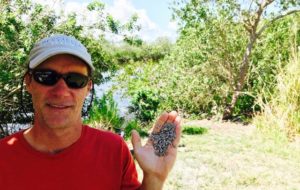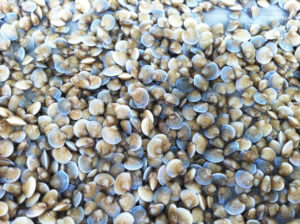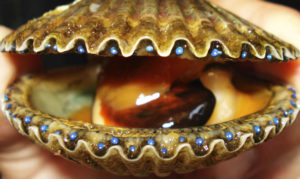
Curtis Hemmel, owner and operator of Bay Shellfish Company.
By Lauren Moore, FSA Public Affairs Specialist
Bay Shellfish Company is a commercial hatchery in Florida, located south of the Tampa Bay area on Terra Ceia Island. The operation, opened in 1996, is the first commercial hatchery to produce commercial oyster seed in the state.
“We produce shellfish for research, restoration and commercial production,” said Curtis Hemmel, owner and operator of Bay Shellfish Company.
Hemmel’s company is one of the largest and oldest operations in the southeast United States to produce bivalve seed for the clam and oyster farming industry.
On Sept. 10, 2017, Hurricane Irma made landfall in Florida, impacting communities and agricultural operations across the state. Hemmel was one of the many producers who sustained damage and losses caused by the devastating storm.
“The good news is we had time to prepare for the storm,” Hemmel said. “We had about three days to evacuate as much equipment from our facility as we could. We were very lucky in that respect.”
While they could evacuate some of the equipment, some items, due to size and weight, had to be left behind.

Hemmel was one of the many producers who sustained damage and losses caused by Hurricane Irma.
“Had we not evacuated equipment and reinforced what was left, we would’ve lost more production time than we did,” he said.
While his family evacuated the island before the bridges were closed, Hemmel and an employee stayed on the property during the storm.
“We had significant physical losses,” he said. “All of the roofs on our greenhouses were damaged. We didn’t have the choice to take those off before the storm because they were a source of protection for what was underneath. We had to take our chance and hope for the best.”
According to Hemmel, between the massive amounts of rain and the lack of electricity, the majority of the shellfish in the nursery died.
“We were without power for five days,” Hemmel said. “Our operation requires a fair amount of electricity to run and there were just too many areas to cover with the generators we had.”
Hemmel was able to recover some of his losses after the storm through the Noninsured Crop Disaster Assistance Program (NAP), a safety-net program offered by the USDA Farm Service Agency (FSA). NAP provides financial assistance to producers of noninsurable crops when low yields, loss of inventory or prevented planting occur due to natural disasters.

Bay Shellfish Company is one of the largest and oldest operations in the southeast United States to produce bivalve seed for the clam and oyster farming industry.
Hemmel enrolled his shellfish in the program in 2011 and has maintained coverage ever since.
“Thank goodness for NAP, it gave us needed risk mitigation,” he said. “NAP is an essential program. Programs like this are so important to the growth of the U.S. aquaculture industry, it allows people to continue to operate.”
Along with his commercial interests, Hemmel helps with various research projects to improve the industry and move it forward. The company helped start the Gulf Shellfish Institute in 2015, a non-profit with a mission to “facilitate, support and encourage increased production of shellfish in Florida and the Gulf region for both economic and environmental benefit.”
To give back, Bay Shellfish Company has been committed to the Florida Bay Scallop restoration efforts. For over 10 years, Hemmel has been able to grow a variety of scallop sizes to be released into the bay.

Bay Shellfish Company has been committed to the Florida Bay Scallop restoration efforts for over 10 years, growing a variety of scallop sizes to be released into the bay.
“I’ve always believed it’s important to look at the big picture and give back to your community,” Hemmel said. “We are committed to help with restoration in any way we can.”
For more information about NAP, visit https://www.fsa.usda.gov/. Deadlines to apply for NAP coverage vary by state and crop. To enroll, contact your local FSA office to schedule an appointment. Find your USDA Service Center by visiting https://www.farmers.gov/.





